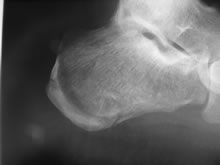
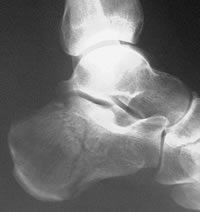
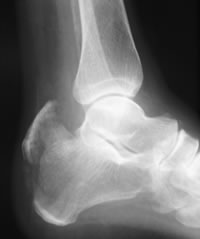
Plain radiographs
The traditional plain radiographs are a lateral hindfoot view and an axial view of the calcaneum. Utukuri et al (2000) showed that the axial view contributes little to the diagnosis of fracture, and CT will be required if surgery is planned. Therefore, as it painful for the patient to obtain an axial view and it represents a radiation dosage, we do not routinely use this view in the emergency department. It is useful intra-operatively to show reduction of the body and medial wall fragments.
 |
 |
 |
| Fracture of the tuberosity | Extra-articular body fracture | Posterior avulsion fracture pulled off by the Achilles tendon |
The lateral view not only allows the diagnosis of a body or peripheral fracture to be made with confidence in most cases, but with careful analysis will give useful information about damage and displacement of the subtalar joint. Indeed, Ebraheim (1996) has shown that the plain lateral view will give additional information on subtalar fragment displacement compared with CT in 25% of patients.
On the lateral view, the principal landmarks are:
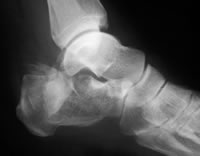 |
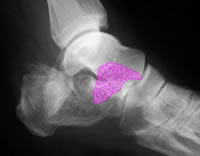 |
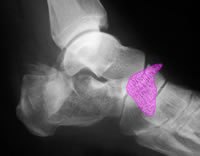 |
| Lateral hindfoot view | The posterior subtalar facet should be here... | ...but it has rotated downwards and posteriorly to here |
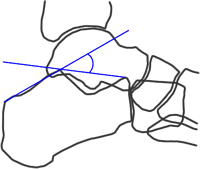 |
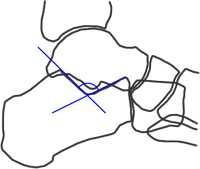 |
Bohler's angle |
Gissane's crucial angle |
Tomography
May be used if CT is unavailable but may fail to show joint incongruity adequately.
Broden’s views
AP views with leg internally rotated 30°. Films are taken with tube angled 10°, 20°, 30°, 40° toward head.Broden views show the joint surface well, but probably underestimate displacement compared with CT. They require expertise on the part of the radiographer. Although CT is preferable, they may be useful if this is not available, and are useful intra-operatively to assess reduction of the subtalar facet, and post-operatively to assess maintenance of reduction.
CT
CT should now be considered the gold standard for assessment of intra-articular os calcis fractures. It gives excellent images of subtalar joint surfaces, degree of displacement (Janzen et al 1992) and soft tissue injuries (Bradley and Davies 1992). It may not be so good for imaging the calcaneocuboid joint. Imaging of the subtalar joint is superior to plain films (Janzen et al 1992); no study that I can find has compared Broden views with CT. However, the plain lateral view will cantribute additional information in 25% of patients (Ebraheim 1996). Both feet should be scanned, with image acquisition in both coronal and axial planes. The CT gantry is inclined to be at right angles to the subtalar joint surface. 3-D reconstructions may be performed, although their value is debatable. |
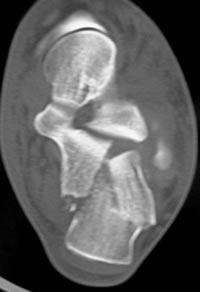 |
| Coronal CT of a type 2B fracture |
MR
MR has been described in the assessment of calcaneal fractures. It gives excellent imaging of soft tissue injuries, especially to the peroneal tendons. However, CT usually gives superior imaging of bone and no study has shown that MR adds important information in the typical patient.